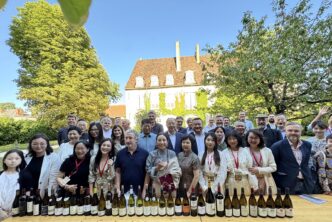It’s been some time since Bourgogne enjoyed two consecutive years with above-average volumes. It is said that the 2023 vintage, following the also copious production of 2022, has put a smile on the faces of farmers, winemakers and wine merchants: cellars are (almost) full again with what appear to be high-quality wines. The following is an abridged version of the excellent report published
The 2023 Vintage in Bourgogne
One of the great things about the 2023 vintage, despite unstable weather conditions over the summer, is that the end result appears to be stunning. The Chardonnay, Aligoté and Sauvignon Blanc grapes reached full maturity in perfect condition, while retaining enough freshness to live up to the reputation of Bourgogne white wines. And Pinot Noir proved itself yet again.
The 2023 vintage appears to have resulted in expressive, fruity wines with beautiful aromatic profiles, for both white and red. There’s something for all tastes, as this vintage offers a range of profiles linked to the choice of harvest dates.
Relative to white wines, it appears that everyone in Burgundy believes 2023 is “a great year for white wine”.
The ripe, healthy, well-balanced grapes have produced wines that stand out for their richness and wonderful opulence, without excesses. The wines are perfumed, evoking gorgeous ripe white fruits such as pear and peach. Despite the very hot weather at the start of the harvest, beautiful balances have been apparently maintained. The red wines promise to be approachable and easy to drink, as they are already expressive and open up quickly. They have delicious flavours, in some cases reminiscent of fresh red fruits, such as raspberries, or with aromas of dark fruits, such as blackberries, and even spices in some wine profiles. On the palate, they have a lovely density, with a silky tannic structure. During vinification, conditions were just right for good colour extraction. The deep, intense colours of the wine are superb. The basic Crémant de Bourgogne wines are fruity, balanced and elegant. The Chardonnay has an aromatic profile featuring citrus and floral notes, or even exotic fruit. The Pinot Noir hints at red berries such as raspberry and cherry. The Aligoté maintains its vivacity with lemony notes. Finally, the expressive Gamay has flavours reminiscent of strawberry.
Climatology of the 2023 vintage’s growing season
Year after year, climate change presents its challenges, such that the “exceptional is becoming the norm”. Fortunately, Burgundy’s farmers and winemakers have adapted to capricious weather conditions, redoubling their attention in the vineyard and their skill in the cellar. To the great delight of everyone, the harvest was a stunning one, both in terms of quality and quantity, especially for the Chardonnays. The Pinot Noir grapes also benefited from the September sunshine to reach peak ripeness, while the lavish bunches of grapes enabled us to sort for quality and keep the best of a rock- and-roll year.
Despite a milder winter than usual, budburst was a few days later than average, due to unstable weather until April (with rapidly alternating warmer and cooler-than-normal days). This slight delay meant the risk posed by the rare spring frosts was averted. The very first green tips were observed on April 2 on Chardonnay vines in early areas, then on Pinot Noir and Gamay vines on April 12. As soon as budburst began, many plots showed a degree of variation, which lasted until the harvest. This is due to a staggered regrowth of the vines after the excellent 2022 harvest. A rollercoaster spring followed, but a fine crop of grape bunches was ultimately had. At the start of May, conditions became favourable for growth. The phenological stages followed on, one after another, at a frenetic pace. As the days went by, the leaves unfurled, finally giving the landscape its verdant hue, typical of the season. From May 20 onwards, temperatures rose and remained above the seasonal norm, encouraging rapid progress towards flowering. The very first flowers appeared at the end of May. The mid-flowering stage followed on June 7, heralding a harvest for early September. On the whole, the flowers came into bloom in excellent conditions, with favourable temperatures and plenty of sunshine. Localised thunderstorms provided water at the very end of flowering, allowing the flower caps to fall off and encouraging wind pollination. The emergence of generous bunches of grapes reassured winegrowers of the coming harvest’s potential. The spring ended with a water deficit which didn’t hold back the campaign at all, notwithstanding thunderstorms in June which brought some very heavy rainfall (in the Côte d’Or in particular, with 80 mm to 140 mm at a time).
The summer months proved a roller-coaster ride. July, like June, was relatively unstable, with alternating thunderstorms, temperature peaks of up to 35-36°C and high humidity. This kind of volatility is conducive to disease, and winegrowers remained vigilant throughout the summer. Two hailstorms on July 11 and July 15 caused very localised damage (south of Mâconnais, north of Côte Chalonnaise, Meursault, and around Dijon). However, Bourgogne was generally unscathed, as could be seen by the vineyards of Chablis and Grand Auxerrois. In early-ripening areas, the first grapes in the veraison stage – when they begin to change colour – were observed between July 11 and July 18, depending on the sector. Temperatures remained relatively mild, with a fairly wide day/night range, which was very beneficial to the vines.
The grapes ripened in warm, sunny conditions, allowing a steady build-up of sugar. August, punctuated by rainy spells, enabled the harvest capacity to be maintained, before ending with unseasonably high temperatures and sunshine. For this reason, many winegrowers decide to pick at night or in the early hours of the morning. This preserves the freshness of the grapes and the quality of the vintage.
The Crémant de Bourgogne of Mâconnais (Lugny) kicked off the harvest on August 25. Temperatures were more than 35°C in the sun and these would last until the end of the first week of September. Picking for the still wines took over at the beginning of September, starting with the white wines, especially in plots in the early sector. Next came the Pinot Noir, around the second week of September. The plentiful and lavish clusters of grapes took advantage of the late summer sunshine to perfect their ripeness. The harvest spread out from the south to the north of Bourgogne, ending in late September in Chablis and the Hautes Côtes.
The Chardonnay and Aligoté grapes were magnificent. More attention was devoted to the Pinot Noir grapes, which are more sensitive to heat. They required careful sorting, both in the vineyard and at the entrance to the cellar, to remove the scorched or wilted grapes, although the bunches were in excellent condition.
Vinification, once it began, filled the cellars with delicious aromas. The fermentations went well and, after a few weeks, it was possible to distinguish the different profiles that began to emerge. Ageing has begun in the cellars for this vintage, the volume of which will allow stocks to be replenished. We look forward to trying it. Bourgogne has something to look forward to.



The 2022 Vintage in Bourgogne: Promise Fulfilled!
The 2022 vintage – long-awaited and hoped for after the small crops of 2021 and much acclaimed and celebrated following the harvest – is now living up to all its promise. It’s a very fine vintage, with wines that are seductive when they are young, but that will also age beautifully.
Nevertheless, the 2022 vintage was the fruit of a very intense, even difficult, year weather-wise, with frost, heatwaves and drought. Production volumes, saved by a slightly later budburst which protected the buds from frost, could have been impacted by the four summer heatwaves and a widespread shortage of water. But the vines were able to draw on their own resources as well as those of the terroir, giving Burgundy generous yields (nearly 1.75 million hectolitres). This connection between the vines and their environment has also brought a beautiful balance to the wines which, despite the very hot conditions of that year, have a great deal of subtlety, both on the nose and on the palate.
White wines
In the Chablisien and Grand Auxerrois, the 2022 vintage featured the return of rich wines, characterised by a broad aromatic range. Delicate notes of lemon and bergamot are joined by lovely hints of white and yellow fruit, mingled with subtle floral scents. Aniseed and sweet spices are accompanied by a very pleasant fruitiness. The generous palate is perfectly balanced and well-structured, with a refreshing, mouthwatering finish. It is believed the 2022 vintage wines can be enjoyed while young, yet has excellent ageing potential. In the Côte de Beaune, the harvest was a generous one and was also of excellent quality. Maturity is the order of the day, with particularly aromatic wines. Hints of citrus and ripe fruit mingle with delicate floral notes, often accompanied by slightly spicy, patisserie flavours. On the palate the wine is tender and fleshy, with good body.The pleasant roundness and gourmet finish mean wines of this vintage are well-balanced, with excellent ageing potential. In the Côte Chalonnaise, the 2022 weather allowed the grapes to attain perfect ripeness. This naturally translates into wines with very expressive aromas and soft mouthfeel. Subtle floral scents accompany ripe fruit aromas of peach, apricot and pineapple. After being allowed to breathe, seductive notes of candied fruit and spices emerge. The palate is soft and supple, full-bodied and with good length. The 2022 vintage is undoubtedly a high-quality one that has everything to satisfy lovers of fine wines. In 2022, the Mâconnais reaffirms its high quality. The wines have an exemplary richness and a beautiful freshness. Bouquets are pleasing, intense and generally characterised by notes of ripe fresh fruit such as peach, pear or apricot. Lime blossom, acacia flower and patisserie aromas complete this impressive aromatic range. On the palate, balance and harmony go hand in hand, perfectly matching the structure and supple texture of this vintage. A landmark year of excellent quality and true pleasure.
Red wines
The wines of the Grand Auxerrois showcase perfect ripeness of the grapes resulting in wines with real colour intensity and magnificent aromatic expression. The bouquet is a veritable explosion of red berries and dark berries, a sublime pleasure combining blackcurrant, blueberry, elderberry and morello cherry. With their silky tannins and lightly spicy, fleshy mouthfeel, these wines are a delicious treat that will satisfy even the most demanding wine lovers. A great vintage from this northern vineyard of Bourgogne. Like its neighbours, the Côte de Nuits reaffirms its excellence with this 2022 vintage. The wines will wow you with their lively colour. The highly complex bouquet combines aromas of blackberry, blueberry and blackcurrant with floral scents of peony and violet. On the palate, spices underscore the silky, high-quality tannins. Ample, full-bodied and beautifully fresh, these wines are a perfect example of their type, with real ageing potential. With 2022, the Côte de Beaune also returned to a sunnier vintage. The deep ruby-red wines have developed aromas of red berries, dark berries and spices. Raspberry, strawberry and Morello cherry rub shoulders with blackberry, blackcurrant and tobacco. Perfectly balanced on the palate, they are dense and full-bodied, but thanks to the quality of their tannins, they remain supple and delicious. With 2022, it is believed that the Côte de Beaune signals a vintage of the highest quality. The Côte Chalonnaise enjoyed another landmark vintage in 2022, thanks to the perfect ripeness and good quality of the grapes. The wines are richly aromatic, with floral scents inextricably associated with fruity aromas. Balanced and magnificently structured, their long finish is impressive. Already very enjoyable, they can be appreciated for many years to come.

The weather in 2022
Conditions were tricky for the 2022 vintage, from intense sunshine and heat to lack of rainfall (see graphs below). Once again, the vines astonished by their ability to make juice from almost no water at all: Once the bunches formed, they enjoyed heavy rain in June and a few stormy showers mid-August to produce abundant, aromatic, and balanced juice.
After a winter that was milder and drier than usual, the very first green shoots were observed in the early days of April. A mass of cold air from the north caused temperatures to drop across the Bourgogne region, and winegrowers had to battle with four nights of frost, between 3-11 April. They feared the worst but despite some damage in the earliest ripening sectors, the situation was much less serious than in 2021. Moreover, the weather warmed up immediately, allowing the vines to quickly return to growth and to develop secondary fruit-bearing buds. In mid-April, summery temperatures and a lasting dry spell encouraged the vines to grow rapidly. The vines grew frantically and growers could barely keep up with topping out and raising wires. This went on until flowering, which happened between 19-26 May, two weeks earlier than the average. The exceptional temperatures during the month ensured flowering happened in excellent conditions, with very little shatter and just a touch of millerandage. The bunches formed very well, already suggesting a generous and possibly very early harvest. The weather remained good and fruit set occurred around two weeks ahead of schedule. Winegrowers began to pray for rain as drought began to take hold. Then finally, the long-awaited rainfall arrived in the form of thunderstorms between 21-25 June. An average of 50mm of rain fell across the region, but locally, this varied between 20-90mm, depending on the sector. The storms were sometimes violent, with some significant damage from hail, but only in limited areas. As such, cumulative rainfall in June was much higher than normal (see graph below), and the vines benefited, taking in enough water to get them through the whole summer.
The grapes ripened in full heatwave conditions, which helped keep disease at bay. There were four periods of heatwave across the summer, but consequences were limited. Vines can withstand both high temperatures and low rainfall, although younger plants and plots on shallow or sandy soils suffered more. Ripening was closely monitored and sugar levels progressed well in general, but less well in certain plots during the first two weeks of August. This was a result of the lack of rain and such disparities are translated into the harvest. The winegrowers got ready for picking while still waiting for rain, which finally fell in mid-August, allowing the vines to finish ripening and produce their juice.
In the end, this was not the earliest vintage we have seen in recent years. Harvesting began slowly on 16 August for some Crémant de Bourgogne vines. Grapes for still wines began to be gathered on 20 August on the Côte de Beaune, while the Crémant de Bourgognes picked up the pace. The rest of the region followed on behind, with the last bunches brought in from the Côte de Nuits, the Hautes Côtes, and the Chablis region during the third week of September.
It was an unusual harvest in that picking was spread out over several weeks. This was due to a diversity in ripeness, good weather, and unexpected volumes. Ripeness checks coupled with berry and juice tastings were the only guides. Almost all the grapes had good sugar levels towards the end so it fell to the acidity content to determine when the grapes needed to be cut. Yields were high for both white and red, with crates filled with perfect bunches leading certain producers to vinify in whole bunches. Vinification went well, and when the must went into barrels it was confirmed that despite it being a dry year, yields were very satisfactory indeed.

 中文
中文



